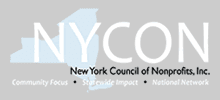November 19, 2009
Holiday Inn Liverpool
9:00 a.m.-9:45 a.m.
Concurrent Session 1
Section APanel Discussion
Mission Refinement: Program Prioritization/Program ReductionPat Leone, Contact Community Services, Inc.
Linda M. Wright, The Salvation Army of the Syracuse Area
Michael F. Melara, Catholic Charities of Onondaga County
Section BDefining And Developing Your Organization’s Strategic Plan, Business Plan And BudgetSusan Burgess, MA, MS, True North Group
Section CPanel Discussion
Forming Strategic PartnershipsMary Ellen Bloodgood, Jewish Home of Central New York / Menorah Park
Dr. Thomas H. Dennison, Syracuse University’s Maxwell School Health Services Management and Policy
John G. Eberle, Central New York Community Foundation
Michael West, New York Council of Nonprofits, Inc.
10:00 a.m.-10:45 a.m.
Concurrent Session 2
Section DPanel Discussion
Staff Issues In The Downturn – Compensation And RetentionPeter A. Jones, Esq., Bond, Schoeneck & King, PLLC
John E. Matson, Syracuse University
Section EExploring Funding StreamsSpeaker TBD, New York State Energy Research and Development Authority
Section FPanel Discussion
Managing Volunteers From Acceptance Through The Volunteer Life Cycle/Creating “Meaningful” WorkKaren Hargrave, Vera House
Craig Collie, United WayNancy Stewart, Crouse Hospital
11:00 a.m.-Noon
Plenary Session
Panel Discussion
Attracting And Engaging The “40 Below” Board Member And VolunteerKelly Bayne, United Way of Central New York, Inc., 40 Below Civic Engagement Task Force
Sean Becker, 40 Below Civic Engagement Task Force
Brian Hoke, 40 Below, Thursday Morning Roundtable Advisory Committee
Kelly Knab, United Way of Central New York, Inc.
Agenda
7:30 am - 8:00 am
Registration and Continental Breakfast
8:00 a.m.-9:00 a.m.
Keynote Address
ePhilanthropy: Using the Web for Fundraising
Erica Campbell, Assistant Vice President, CCS Fundraising
LOCATION
Holiday Inn Syracuse/Liverpool, 411 Electronics Parkway, Liverpool, NY 13088 315-457-1122
REGISTRATION
November 19, 2009 Liverpool, New York
Registration Fees: $70 – BS&K/ParenteBeard LLC Clients $85 – General PublicRSVP Deadline: November 12, 2009Please indicate which of the Concurrent Sessions you will attend:Session 1: A B C Session 2: D E FRegister online at www.bsk.comor complete and return the registration form below.
Name:_________________________________________________Title:_______________________________________________Organization:________________________________________________________________________________________________Address:___________________________________________________________________________________________________City:___________________________________ State:____________________________ Zip:______________________________E-Mail:_______________________________Telephone:____________________________Fax:____________________________The following people will also attend:Name:____________________________________Title:______________________________ E-Mail:_________________________Name:____________________________________Title:______________________________ E-Mail:_________________________Name:____________________________________Title:______________________________ E-Mail:_________________________Refunds will only be made for cancellations received 5 business days before event.Register online at www.bsk.com or complete and return the registration form to:Ms. Toko Moyo, Bond, Schoeneck & King, PLLC, One Lincoln Center, Syracuse, NY 13202Fax: 315-218-8100 Questions: 1-800-339-8897 E-mail: tmoyo@bsk.comPlease make checks payable to Bond, Schoeneck & King, PLLCIf anyone attending needs any special accommodation, please call Liz Poda at 315-218-8526.This seminar is intended for the invited guests of Bond, Schoeneck & King, PLLC, Central New York Community Foundation, Inc.,The Gifford Foundation, ParenteBeard LLC and the United Way of Central New York, who reserve the right to deny admission to any applicant.












